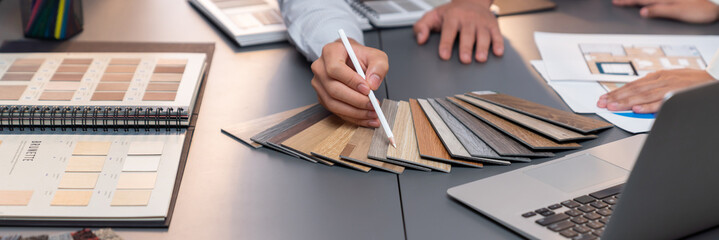The flooring choice you make will impact the look and feel of your entire home. It is a significant decision that can seem overwhelming, especially if you’re trying to weigh aesthetics and comfort against practicality.
If you love the look of hardwood but aren’t ready to commit to its upkeep, engineered wood may be a good option for you. This floor consists of a layer of hardwood bonded to compressed plywood. If you don’t know what to do, contact Thompson & Boys LLC experts to get started.
 Hardwood
Hardwood
Hardwood floors are timeless, adding an elegant and inviting touch to any home. They are also extremely versatile and blend well with any decorative style, from traditional to contemporary. Unlike carpet or linoleum, wood does not conflict with different decorative accents or colors and can be stained to match the rest of your home decor. Additionally, hardwood can be refinished to restore it when needed, making it more durable and long-lasting than other flooring options.
Unlike tile or linoleum, which can be made from synthetic fibers, hardwood is a natural material that comes from trees. Moreover, since it is renewable, the use of hardwood flooring helps reduce your carbon footprint. In addition, if you choose to get hardwood floors in your home, it will last for decades and increase the value of your property over time.
In contrast, if you opt for a carpet, it will need to be replaced or reupholstered more frequently due to its wear and tear. Moreover, hardwood is much easier to clean and maintain than other types of floor coverings. This makes it a great choice for households with kids and pets.
Another reason why hardwood floors are a smart choice is that they do not attract allergens like dust, pet dander, and other pollutants as easily as carpet does. This is because the grain patterns and natural color of hardwood flooring make it difficult for allergens to hide or settle in. On the other hand, carpets are prone to collecting and holding these contaminants, making them difficult to clean.
Additionally, solid hardwood floors have a naturally smooth surface that is easy to sweep and vacuum. This makes it easy to remove any dirt and dust that might be trapped on the surface of the floor, reducing the risk of allergies and promoting healthier air quality in your home.
Tile
Tile is a versatile material that can work in any room of your home, from kitchens and bathrooms to foyers, mudrooms, and living spaces. It’s particularly well suited to high-traffic areas of your home like hallways and living rooms because it is so durable. It can withstand the stomping of snow boots, soccer cleats, and the general wear and tear that occurs in those types of busy areas. It also stands up to moisture very well, and it won’t absorb odors or bacteria.
In addition, tile is available in an incredible array of colors and styles that are suitable for any design scheme. From simple, square, and glazed ceramic tiles to floral, marble, and natural stone-like options, you’ll find many different ways to add a pop of color or pattern to any space. Additionally, you can create a unique aesthetic by using tile to create patterns and shapes that are not traditionally used for flooring such as herringbone or straight-stacked layouts.
The other advantage of tile is that it is very easy to maintain. Simply sweeping and mopping regularly will keep your tile floors looking clean and beautiful for years to come. Additionally, if you want to add a layer of protection to your tile, you can apply a sealant to it every five years or so to help keep it looking fresh and new.
Finally, if you live in an area with a warm climate, you’ll find that tile flooring can save you money on energy bills as it doesn’t retain heat the way carpets or wood do. This can make your house feel much more comfortable in the summer without the need to crank up the air conditioning.
Tile is one of the more versatile and affordable flooring materials that you can use in your home. It can be installed in nearly any type of space and you’ll have the added benefit of knowing that it will increase your home’s resale value when the time comes to sell. If you are considering installing tile in your home, contact a local flooring company that specializes in the installation of different types of tile flooring.
Laminate
Since its introduction in the 1970s, laminate has come a long way in terms of quality and appearance. It’s a synthetic material that can look like traditional wood or stone but is much cheaper. It’s also easy to install and can be used in most rooms in the home.
Laminate consists of a photographic layer enclosed in several protective and high-density layers. This makes it strong, water resistant, and durable, making it a great choice for high-traffic areas and homes with kids and pets. It can take the beating from heavy furniture without warping or damage to the floor. Its tough exterior and resin coating protect it from scratches, dents, and other damage. A wear layer protects the surface of the floor from stains, scrapes, and scuffs that can be caused by shoes, pet claws, kids’ toys, table legs, and even the dusting of household appliances. It also protects the decorative paper layer from harmful ultraviolet rays that can fade the color of the floor over time.
Unlike solid wood, which is sensitive to moisture, laminate is water-resistant. If the boards do come into contact with excessive amounts of moisture, however, they can be susceptible to swelling and warping. This is why it’s important to have your laminate flooring installed by a reputable, experienced flooring contractor. They can ensure that the installation process is carried out correctly and with care, leaving you with a durable floor that will last for years to come.
Laminate floors are generally easy to maintain. They can be swept and vacuumed regularly to remove any dirt, dust, or grit. When necessary, they can be mopped with plain water or an acetone-based cleaner (such as nail polish remover) to tackle more stubborn stains. The water resistance of laminate also means that it can be laid in areas such as kitchens and conservatories where spillages can be more frequent and the humidity fluctuates more than in other parts of the house.
Because of the durability and cost-effectiveness of laminate, it’s a popular flooring choice for families and people with hectic lifestyles. It’s an excellent option for those who want the classic look of natural wood but aren’t able to afford or manage the maintenance costs associated with real hardwood floors.
Vinyl
Vinyl continues to be a popular choice for flooring because of its durability, affordability, and style. It is also easy to clean and maintain. It is a good option for moisture-prone areas, such as the kitchen, bathroom, laundry room, or basement. The latest vinyl styles are also available in a wide range of textures and patterns, such as distressed or hand-scraped wood. They can also mimic the look of natural stone, slate, and travertine.
Unlike some other types of flooring, such as laminate, vinyl floors are relatively water-resistant. This makes them a good choice for kitchens, bathrooms, laundry rooms, mudrooms, and basements. It is also very easy to install and can be done as a do-it-yourself project.
Vinyl is made from polyvinyl chloride (PVC) resins with plasticizers, stabilizers, pigments, and additives. It is coated with a layer of UV-cured urethane, which gives it good resistance to scratches, scuffs, and stains. It is a good choice for high-traffic areas because it resists fading from sunlight and is easy to clean.
Modern vinyl is also eco-friendly. Many brands are certified. This means they produce very low levels of volatile organic compounds (VOCs), which help improve indoor air quality.
Although vinyl is a resilient material, it still requires some care and maintenance to keep it looking good. Regular sweeping, mopping, and vacuuming are recommended. It is not as durable as other types of flooring, such as hardwood or tile, so it is not recommended for areas with heavy foot traffic or furniture. It is also not as resistant to damage from sharp objects or pet claws.
Despite these limitations, vinyl still has its place as a beautiful and durable floor covering that is suitable for most areas of the home. It is an excellent option for a family or pet-friendly environment and comes in a huge selection of designs and colors. It is an inexpensive and quick way to spruce up your home, without the added cost of real wood or natural stone floors.
